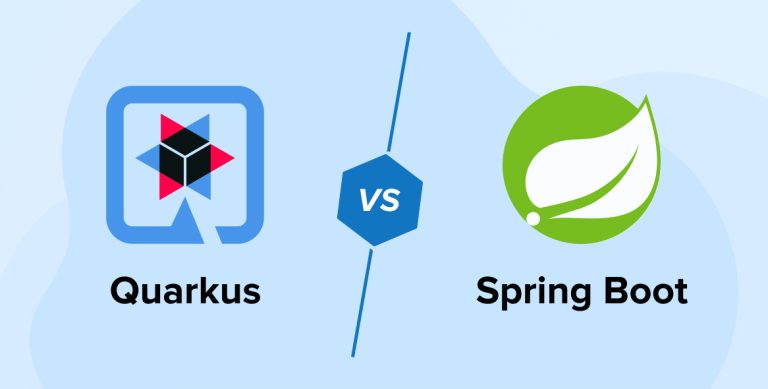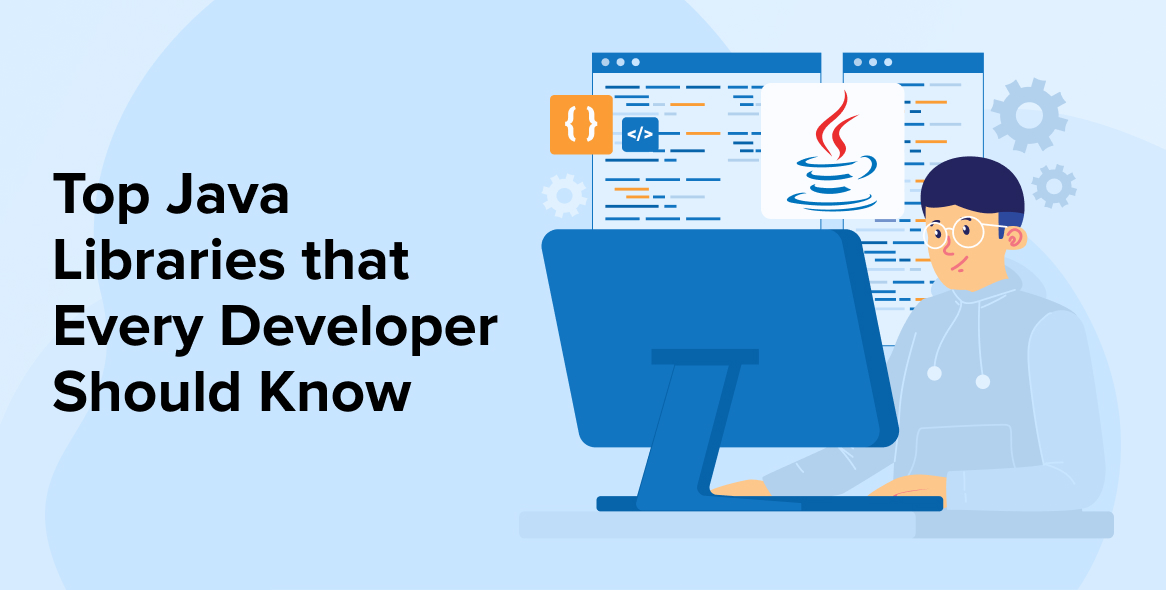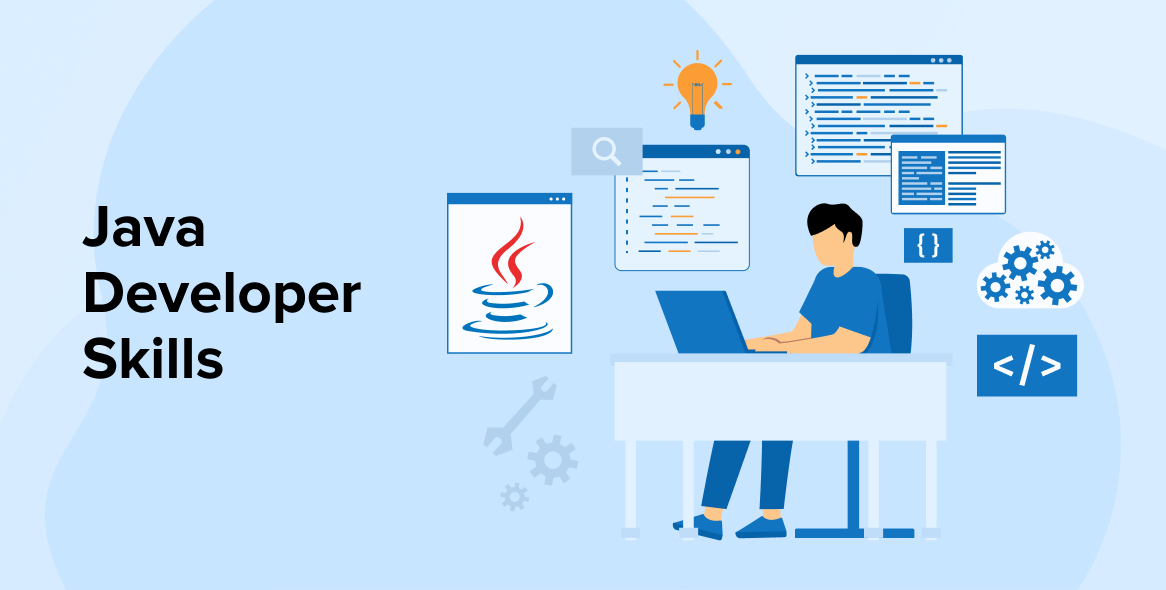
Microservices are recently trending for building modern applications. They simplify the design, prototyping, building, and deploying apps using microservices frameworks. This has led to increased demand and popularity of these frameworks.
Among the entire lot, Spring Boot and Quarks are the two names that catch the eye. Both are designed for Java development services, enabling the creation of microservices and cloud-native applications.
This article features Quarkus vs Spring Boot, a comprehensive comparison of their features, benefits, limitations, and a few standard industry parameters.
1. What is Quarkus?
Quarkus is a full-stack, Kubernetes-native Java framework designed for both native compilation and Java Virtual Machines. It has proved to be an effective framework for working in Kubernetes, cloud, and serverless environments.
Quarkus designed upon popular Java standards and the best Java libraries, addresses suitable for a large array of distributed application architecture. This framework enables the developers to implement Java best practices in building applications for a modern, cloud-native world.
Quarkus is compatible with many virtual machines, libraries, and frameworks, including Hibernate ORM, Apache Kafka, GraalVM, Spring, RESTEasy, and more.
2. Features of Quarkus
This section highlights the aspects of Quarkus that distinguish it from other Java frameworks.
2.1 Developer-Friendly
Quarkus is easy to use and provides a wide range of tools and libraries. Developers can choose an appropriate option that helps them achieve their goals. Moreover, this open-source Java framework is easy to use and doesn’t need any configuration. So, Quarkus not only offers a seamless development experience but also an enjoyable one.
2.2 Kubernetes-Native
10 reasons to build your next Java app w/ Quarkus
— QuarkusIO (@QuarkusIO) May 21, 2024
#2: Create Kubernetes-native applications
Quarkus is a Kubernetes-native framework designed, built, and optimized for containers, so you can deploy applications without a detailed understanding of the underlying infra- structure pic.twitter.com/mjciFFK7mW
Quarkus simplifies the development of applications on Kubernetes without worrying about the platform’s complexities. Developers can use Quarkus to automatically generate Kubernetes resources, such as container images, making the release process easier and more effective.
2.3 Imperative and Reactive Code
Most of the developers are familiar with imperative coding and feel comfortable using it in almost every project. However, the imperative style is not suitable for developing cloud-native apps or projects that demand a reactive approach. Quarkus can adapt to any app you are developing because its development model combines reactive and imperative style codes.
2.4 Live Coding
Developers can now make changes to their code without restraining the app, thanks to the live coding feature from Quarkus. This development mode accelerates the software development process.
2.5 Unified Configuration
Organizing and managing configuration properties throughout the application is now easy with the centralized configuration system from Quarkus.
2.6 Faster Startup Time
Quarkus has excellent startup times because of its lightweight design and AOT compilation. This makes it a great choice for projects like auto-scaled environments or serverless architectures where faster boot times are essential.
3. Quarkus Pros
Quarkus is leveraged to gain the following advantages:
3.1 Actively Growing Community Support
10 reasons to build your next Java app w/ Quarkus
— QuarkusIO (@QuarkusIO) June 19, 2024
#6: Join a community of professionals
The Quarkus ecosystem is built, powered, and supported by a dynamic, fast-moving community of developers and backed by Red Hat, a leader in open source technologies.https://t.co/pEDvLdEmMo pic.twitter.com/WKHVpdjFLk
Although it is relatively new, Quarkus is slowly gaining support. Its community is becoming larger and becoming more active, leading to various contributions from leading companies.
3.2 Quality Third-Party Integrations
Quarkus provides third-party integrations while focusing on quality support. This is to offer a smooth and efficient development experience.
3.3 Lightning-Fast Startup Times
Quarkus uses GraalVM to pre-compile applications into native binaries. This helps cut the app’s boot times significantly, allowing you to launch the app quickly. Therefore, developers prefer to use Quarkus for building microservices and serverless architecture that requires quick scaling and low latency.
3.4 Minimized Memory Footprint
The GraalVM-based native compilation in Quarkus helps reduce the memory usage of your program. This approach is very beneficial for microservices released with cloud platforms or containers to environments with limited resources. This also makes your app more efficient.
3.5 Heavily Documented
Ample documentation can be found related to Quarkus on the internet because of the support from various communities.
3.6 Faster Hot Reloads
In Quarkus, changes made to Java code are automatically detected, re-compiled, and deployed. This helps increase the speed of hot reloads.
4. Quarkus Cons
There are some limitations to using Quarkus, including
4.1 Graal VM Installation Complexity
GraalVM is a crucial component of Quarkus native builds. However, the installation process is considered complex to some extent, which may discourage some developers from using it.
4.2 The Learning Curve for Native Compilation and GraalVM
There is no doubt that native compilation and GraalVM are beneficial to developers, but mastering them is not only time-consuming but requires a solid foundation of technical knowledge. Because of this, the learning curve for Quarkus goes higher.
4.3 Lack of Solutions on Forums
Quarkus is a relatively new Java framework. Developers would have to face many problems along the way and not every problem has yet got a solution. Over time, with the contributions from the community, these problems will be solved and the framework will be improved. Until then, developers and organizations have to bear with those problems.
5. What is Spring Boot?
Spring Boot is built upon the Spring framework using Java programming language. It simplifies the process of building, running, and configuring Java web applications. Because it offers a variety of ready-made components and integrations, many developers prefer to use it for developing large enterprise-level applications.
Ready-made components also help speed up the software development process and increase the developers’ productivity. Spring boot consists of several tools such as measurement tools, built-in servers, self-setup tools, and more. It also allows different software programs to communicate with each other.
6. Features of Spring Boot
Some of the key features of Spring Boot are:
6.1 Autoconfiguration
Spring Boot simplifies the setup process by automatically configuring the underlying Spring framework and third-party packages. These autoconfiguration capabilities of the framework help avoid any errors. It also initiates the app with pre-set dependencies. So, developers no longer have to configure them manually, although developers still have the option to override them. The auto-configuration capabilities are triggered by using the annotation ‘@SpringBootApplication’.
6.2 Opinionated Approach
Spring Boot is opinionated about adding and configuring starter dependencies. It evaluates your project requirements and then suggests a package to install using default values for configuration. This way, you don’t have to make any decisions or carry out tasks manually.
To make this happen, you have to define your requirements during the initialization process. At that time, Spring Boot will provide options for different starter dependencies known as Spring starters. You can easily access these by filling out a simple web form on Spring Boot Initializr, without needing to write any code.
6.3 Stand-alone Applications
With Spring Boot, you can create standalone apps that run on their own without any support from an external server. A web server like Netty or Tomcat is already embedded in the app during initialization. All you have to do is start the application and enter the run command and your app will start running on its own.
6.4 Embedded Web Server
The embedded web server enables the apps to test and run on their own in a comfortable environment. Embedding a web server in the app makes them self-contained. This framework supports various web servers, including Undertow, Jetty, and Tomcat. If the need arises and you have to use a different HTTP server then you can’t embed it but exclude it explicitly.
6.5 Spring Boot Actuator
Spring Boot applications are designed to be self-contained and use auto-configuration, there is virtually no manual intervention needed. However, sometimes this can become problematic if you need to know what’s going on inside your apps. The Spring actuator is a tool that helps you resolve this issue providing insights into the application’s performance and health.
Using an actuator provides valuable insights into how your app runs. It tells the beans configured in the app context. It can also trace the HTTP requests that your app manages. Moreover, it tracks data source usage, garbage collection details, and CPU and memory usage.
There are multiple endpoints in actuators from where you can retrieve all these data using RESTful APIs. It also ensures the security of these endpoints to prevent the leak of confidential information with the help of Spring Security.
6.6 Supports Microservices
Spring Boot is one of the best tools for creating microservices. These microservices can be easily integrated with the Spring Cloud robust frameworks. With the ability to embed external servers, each microservice can run as a standalone unit. This encapsulation would make the service independent and lightweight.
Spring Boot allows each microservice to use its database. It also offers flexible and scalable deployment with a centralized configuration for easier management.
Tools like Eureka, and Spring Cloud render dynamic service discovery, allowing microservices to communicate effectively. Additionally, Spring Boot ensures efficient gateway integrations, as well as secured and optimized requests and responses between clients and services.
Further Reading on: Microservices Implementation in Java
7. Spring Boot Pros
The benefits of using Spring Boot are as discussed below:
7.1 Fast and Easy Development
Even beginners can easily create a new production-grade application with Spring Boot.
7.2 Reduced Overall Cost
Features like YAML support, starters, auto-configuration, and more help Spring Boot effectively manage the boilerplate and reduce the development cost.
7.3 Extensive Automation Solutions
Spring Boot offers extensive automation solutions for containers, objects, and dependency configuration. By automating these processes, you can accelerate the development process and minimize manual intervention.
7.4 Large and Active Community
Spring Boot has earned support from a large and active community. This community plays a crucial role in finding suitable solutions to common problems and contributes to the advancement of the framework.
7.5 Comprehensive Documentation and Tutorials
Spring Boot offers well-organized and comprehensive documentation, providing detailed insights to the developers of the framework’s capabilities. Moreover, numerous guides and tutorials are available online to help beginners in getting started with the Spring Boot.
7.6 Spring Ecosystem Integration
This framework can easily integrate with the various components of the Spring ecosystem, like Spring Cloud, Spring Security, and Spring Data. It creates a cohesive and unified development experience.
8. Cons of Spring Boot
Let’s have a look at the disadvantages of using Spring Boot.
8.1 Internal Dependencies Complexity
Spring Boot offers way too many internal solutions, which can limit the options for integration and complicate the development scenario by increasing internal dependencies.
8.2 Slower Startup Times
Spring Boot uses a run-time approach which has a longer startup time in comparison to Quarkus. So, if your app needs quick scaling or deployment in the serverless environment, then Spring Boot is rendered useless.
8.3 Heavier Memory Footprint
Spring Boot runs on JVM, which has a larger memory footprint compared to the native compilation offered by Quarkus. This won’t be a problem for large-scale applications, but it can be a serious issue in resource-constrained environments.
9. Spring Boot Vs Quarkus: Detailed Comparison
After getting an overview of the pros and cons of our contenders, it is time to compare Spring Boot and Quarkus against parameters.
9.1 Popularity
Most developers and companies prefer the Spring Boot for enterprise Java application development. It has become a hallmark for designing complex, tested, and stable solutions.
Meanwhile, the popularity of Quarkus is also on the rise, especially in cases where Kubernetes allows low consumption of resources. That is one of the major reasons why businesses love to use it.
Development with Quarkus is based on industry standards, whereas Spring Boot has redesigned those standards.
9.2 Development Cost
The development cost depends on the developer’s experience and development speed.
According to Glassdoor the average salary of a Spring Boot developer in the United States is $102,472 per year, whereas the salary of a Quarkus developer is hard to find since there aren’t many of them and hence no data is available. Even if a developer learns to use Quarkus with other technologies, it will be expensive to hire someone with multiple skill sets.
Spring Boot significantly speeds up the development process with various out-of-the-box solutions. So, developing large and complex Java applications will be faster and cheaper in most cases.
However, Quarkus also offers features like DevUI and live coding that speed up development, simplifying the task of handling Kubernetes containers. So, Quarkus is faster and cheaper in special cases when Kubernetes containers are involved in your project.
Moreover, Spring Boot has comprehensive documentation and the support of a large and active community. So, if there are any development-related issues, they can be addressed quickly and easily.
Such is not the case with Quarkus. Because it’s relatively new and hence lacks detailed documentation and a large community to help with problems, it severely affects the cost of development.
9.3 Performance
Performance optimization is the forte of Quarkus. It can offer faster startup times and reduced memory consumption, thanks to its native compilation capabilities. When you are required to run Java applications in serverless and resource-constrained environments, choose Quarkus.
Meanwhile, Spring Boot is known for offering productivity, not performance. This Java framework comes with a ton of features and maybe that’s why it takes time to start. Its memory consumption is also higher than that of Quarkus’s. To bring the performance of Spring Boot apps to the same level as Quarkus, you need to leverage different optimization techniques like caching, app profiling, and dependency management.
Further Reading on: Java Performance Optimization
9.4 Development Mode And Developer Experience
Both Spring Boot and Quarkus offer a development mode that significantly improves the coding experience and productivity.
The automatic restart feature in the development mode of Spring Boot allows you to automate the detection of changes in code and restart the app. Eliminating the need to manually restart the app helps you save time.
Moreover, Spring Boot’s development mode also supports hot reloading, allowing you to modify the code when the app is running and immediately reflecting the changes in the browser. This encourages an efficient and seamless development workflow.
Quarkus also offers robust capabilities of live coding and hot reloading in its development mode. Its live coding feature enables the developers to write code and observe the changes in the app in real-time without restarting it. This eliminates the need for repetitive builds and development cycles, accelerating the development process.
9.5 Community Support
Spring Boot has been around for a longer time compared to Quarkus. So obviously it would have a larger community and more support. On top of that, it also offers more resources, tutorials, guides, and sample codes to help developers in their projects. This allows Spring Boot developers to find solutions to their problems quickly.
Meanwhile, the Quarkus is relatively new and still growing. So, it doesn’t have support from a large community, and the resources at its disposal are significantly less than Spring Boot. However, the community supporting Quarkus is very active and responsive. They assist the developers through forums and online communities.
The resources may be relatively fewer compared to Spring Boot. The Quarkus community provides support and assistance to users through forums, mailing lists, and online communities.
10. Conclusion
When choosing a framework for the development and deployment of Java enterprise applications, compare Spring Boot vs Quarkus against your project objectives, technological preferences, and developer skill level.
Spring Boot is a mature and reliable option whereas Quarkus is new and innovative. You have to weigh their strengths and weaknesses to find out which one is the most suitable solution for your project.






Comments
Leave a message...